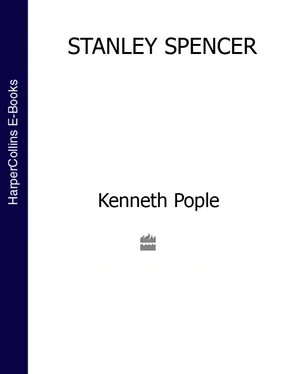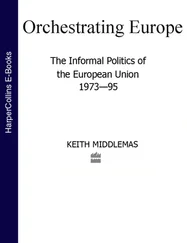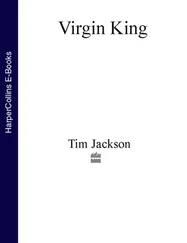Swan Upping demonstrates this particularly well. One of the elements he chose for the composition was the foreground cameo showing two men at work on a punt; a second is that of the two girls carrying cushions to a punt – the sun is in the east, it is morning; the third shows a waterman of the Company of Vintners and Dyers bringing Thames swans ashore for marking. Connecting them, the boardwalk and towpath spike their way towards the lawn of the Ferry Hotel, flag raised to proclaim its services to passing river traffickers. Mr Turk’s boathouse is on the right, and beyond it arches Cookham Bridge. *
Each cameo is a little pocket of feeling. Stanley does not directly describe its nature, but its significance can be extracted from allusions in his writing. Part of his Cookham feelings related to his delight in the occupations of the villagers. The purposefulness of their daily activities made them for Stanley participants in some ritual, as though Cookham were a church, its inhabitants communicants, himself a priest. Not all the villagers gave him this feeling, but those that did became part of his abiding joy:
I hear Mr Johnson’s little boy call ‘Harry, Harry’ down below in the street and I hear his scuttling feet across the gravel as he runs past our house. Our back iron gate swings open and hits the ivied wall [of the house] out of which it is built with a bang, and then quick steps up the [side] passage, then the sound of the milk can opening and of the jug drawn off the window cill. 8
The men tending the foreground punt capture the feeling. Stanley does not tell us who they are but, like the milkman, they are part of his Cookham ritual: men in their physical work, wage-earners, providers of the means to home-making, ‘nest-builders’, angular in presentation.
The girls behind them share the ritual, but differently. Their function is domestic. The cushions they carry are femininely rounded and patterned, suggesting softness. The girls who actually worked at the boatyard for Mr Turk on busy days have had their identity changed by Stanley. 9He has, he tells us, substituted for them the Bailey girls. William Bailey was a local builder and also an accomplished artist, and the family was a joyous strand in his Cookham feelings: ‘Somehow M. S. or Miss Roberts could never quite give me the significance of Cookham that the Bailey girls did, or any other Cookhamite such as Mr Worcester [Wooster?], Pa, Mrs Croper [Cropper?] or Mr Francis or Mr Pym or Mrs Bailey or Mr Hatch. It’s just heaven reciting those names.’ 10It was Dorothy Bailey who gave Stanley his early art training. Her personality caught his imagination, induced his ‘love’: ‘Walking upon the Causeway between white posts placed at the eastern end is Dorothy Bailey. How much, Dorothy, you belong to the Marsh meadows and the old village. I love your curiosity and simplicity, domestic Dorothy.’
Stanley renders unidentifiable the figure bringing ashore the carpet-bagged swans, his elbow lifted, a sack worn for protection against angry beaks and wings. Yet he too is part of the mysterious ritual which makes Cookham holy for Stanley, and which in this painting he has localized along the river because, he says, when in church one day the sounds of river activity filtered in and took on the aura of the religious atmosphere he was experiencing at worship:
My Cookham feelings were really this, that I felt this Ascot-fashion Boulter’s-Lock Sunday Bank-holiday terrific physical life could be tremendous seen spiritually, and this desire on my part was intensified by the fact that Cookham had as far as nature aspects were concerned and as far as the different jobs that were done there (boats and boat-building etc) an affinity with the Bible and the Bible atmosphere. So that in a way all the things that happened at Cookham happened in the Bible. … Of course in this idealizing of Cookham people it was more just my own idealizing of them, my own feelings of perfection projected on to them … 11
If interpretation of the painting stops at this point, it may seem a straighforward rendering of an artist’s powerful place-feelings; three episodes or transformations of experience chosen from many possible, and assembled visually to define an otherwise intangible totality of meaning. But, Stanley being Stanley, we may guess there must be more. The imagined high-angle viewpoint, the packed composition, the geometrical arrangement of components and the density of colour give a charged intensity of feeling which the pacific cameos so far described do not explain.
The high-angle viewpoint was one with which Stanley had been experimenting in visionary work. Its use in Swan Upping was not merely a technical device to shorten perspective and compress into proximity detail normally invisible or discreet when seen from ground level. There was an emotional element. In the back garden of Fernlea grew a large walnut tree which overhung neighbouring gardens. At harvest the Spencer boys would climb into it to shake down the nuts and, as Sydney described and Stanley later drew, sometimes clambered to do so on to a neighbour’s ‘tin sheds’, much to his fury. Stanley as a boy loved to climb alone into the tree. There was always wonder at the unexpected vistas revealed, and also a feeling of isolation, of remoteness, of godlikeness; very much the feeling in the painting.
The angularity given the towpath has, it has been suggested, affinities with cubism and vorticism. 12At the time, Stanley’s former fellow-students Nevinson, Wadsworth and Bomberg were experimenting with the styles, and Stanley was interested to see their work. However, the towpath actually does zigzag as Stanley shows it, the abrupt changes of direction being caused by the property boundaries of the riverfront cottages. Stanley’s artist’s eye instinctively registered such minutiae. But, as with all his visionary work, the painting of the scene was not done from actuality. On the contrary, as he stresses in his description, he drew the scene from memory, returning only afterwards to compare his drawing with the reality and to congratulate himself on the accuracy of his observation.
The comment is significant. Stanley is not painting the scene as a landscape. He is deliberately painting it through the filter of ‘memory-feeling’. The resulting configuration is subservient to the feeling. Of course, most original artists do this. But where many of his contemporaries developed the distortion to carry their meaning, Stanley reverses the process. He aims to bring the configuration of his memory-feeling into as accurate a parallel with the observed as he can, convinced that the more accurately he can do so, the closer he will draw to the power of the associations inherent in the memory-feelings. He will never expect to match the two exactly. There will always be some distortion. When it increased alarmingly in later years, he felt that he had lost this first and early vision, the ‘innocence’ in which he was happiest.
If therefore there is cubism or vorticism in Stanley’s reconstruction of that part of the scene, it is less because he accepted the tenets of those styles than because the angularity was truthful to the place and could be brought into the picture to convey a directness of feeling which would counterpoint the more rounded imagery of the figure associations. But an even more striking counterpoint is evident in the upper part of the painting, the bridge section, which is mysteriously different in feeling from the relative calm of the foreground scene. In the bridge section a wind blows, rippling the water, flapping the flag, sending clouds scudding across the sky, streaming the hair of the male figure as he gazes towards Cookham, towards the female figure at the bridge end where the branches of the fir tree seem to extend her feelings to him in sympathy.
Читать дальше









![Brian Thompson - A Monkey Among Crocodiles - The Life, Loves and Lawsuits of Mrs Georgina Weldon – a disastrous Victorian [Text only]](/books/704922/brian-thompson-a-monkey-among-crocodiles-the-life-thumb.webp)


